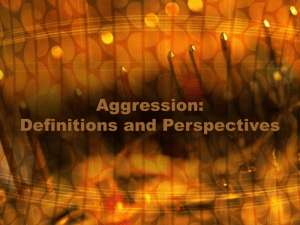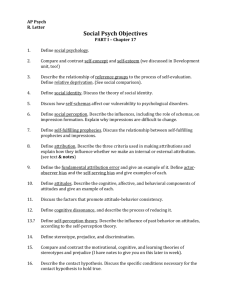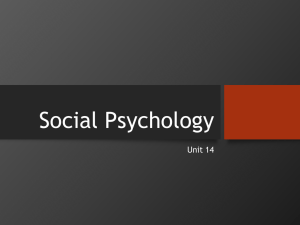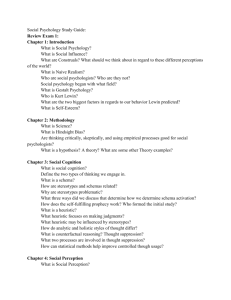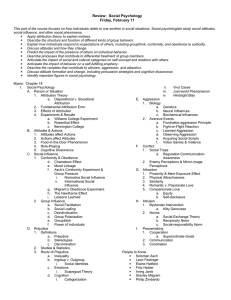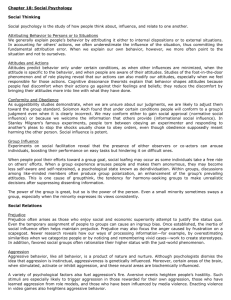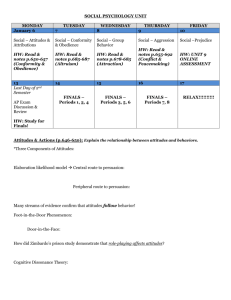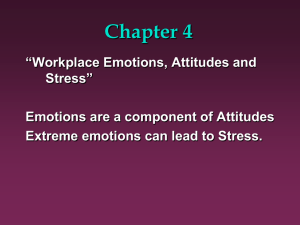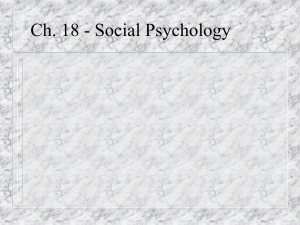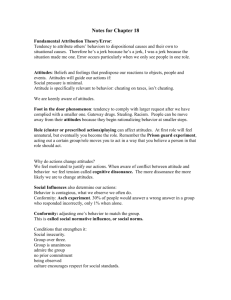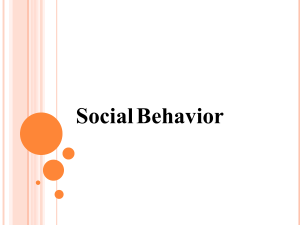Review Sheet Final Exam Sociology 2 Self and Society Instructor
advertisement
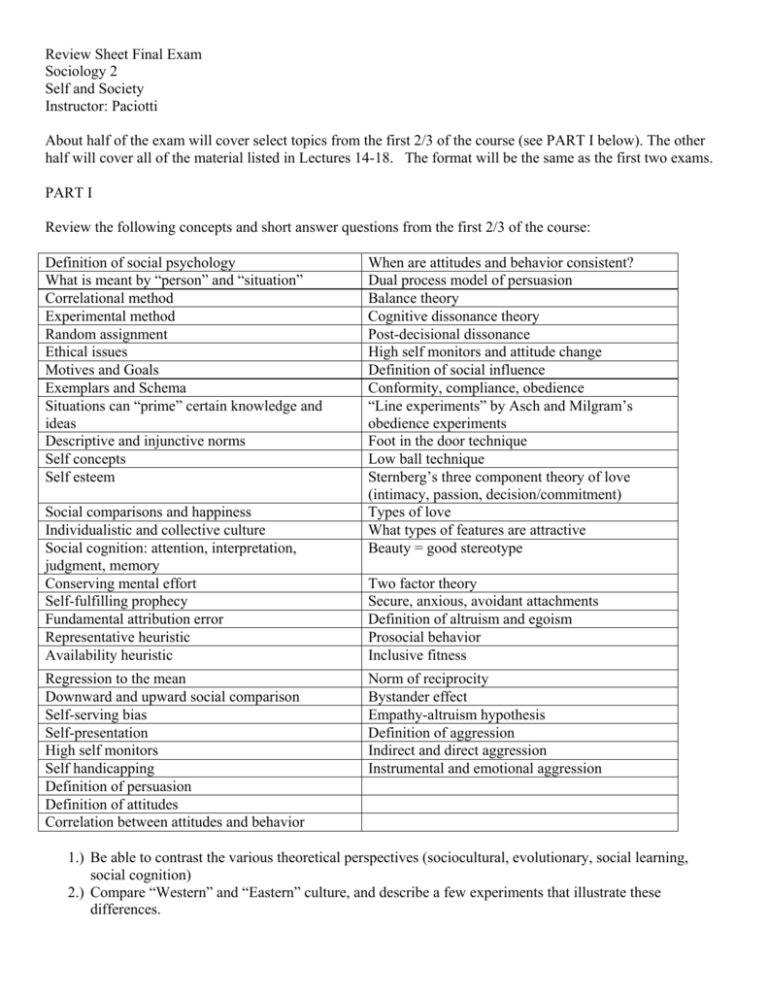
Review Sheet Final Exam Sociology 2 Self and Society Instructor: Paciotti About half of the exam will cover select topics from the first 2/3 of the course (see PART I below). The other half will cover all of the material listed in Lectures 14-18. The format will be the same as the first two exams. PART I Review the following concepts and short answer questions from the first 2/3 of the course: Definition of social psychology What is meant by “person” and “situation” Correlational method Experimental method Random assignment Ethical issues Motives and Goals Exemplars and Schema Situations can “prime” certain knowledge and ideas Descriptive and injunctive norms Self concepts Self esteem Social comparisons and happiness Individualistic and collective culture Social cognition: attention, interpretation, judgment, memory Conserving mental effort Self-fulfilling prophecy Fundamental attribution error Representative heuristic Availability heuristic Regression to the mean Downward and upward social comparison Self-serving bias Self-presentation High self monitors Self handicapping Definition of persuasion Definition of attitudes Correlation between attitudes and behavior When are attitudes and behavior consistent? Dual process model of persuasion Balance theory Cognitive dissonance theory Post-decisional dissonance High self monitors and attitude change Definition of social influence Conformity, compliance, obedience “Line experiments” by Asch and Milgram’s obedience experiments Foot in the door technique Low ball technique Sternberg’s three component theory of love (intimacy, passion, decision/commitment) Types of love What types of features are attractive Beauty = good stereotype Two factor theory Secure, anxious, avoidant attachments Definition of altruism and egoism Prosocial behavior Inclusive fitness Norm of reciprocity Bystander effect Empathy-altruism hypothesis Definition of aggression Indirect and direct aggression Instrumental and emotional aggression 1.) Be able to contrast the various theoretical perspectives (sociocultural, evolutionary, social learning, social cognition) 2.) Compare “Western” and “Eastern” culture, and describe a few experiments that illustrate these differences. 3.) Be able to discuss and provide examples for the following ideas: “Different persons respond differently to the same situation”; “Situations choose the person”; “Persons choose the situation”; “Different situations prime different parts of the person”; “Persons change the situation” 4.) Describe the goals of social cognition and be able to explain how schema and heuristics are an advantage. Also be able to describe disadvantages of these processes. 5.) Review some of the important assumptions from the symbolic interactionist perspective. What are some important differences between this perspective and the “psychological” perspective? 6.) Describe the importance of self-concepts in the symbolic interactionist perspective. What are symbols? 7.) What is the difference between gender and sex? Review the gender differences described in lecture. Contrast how evolutionary theorists and symbolic interactionists might explain gender differences. 8.) Review the theory of sexual selection 9.) Describe the difference between conformity, compliance and obedience. Remember that people are influenced by others because of the need to be liked and the need to choose correctly. 10.) What are some important components about the decision to break up a relationship? 11.) Describe the frustration-aggression hypothesis PART II Review the material in lectures 14-18 1.) Describe social learning theory, and then describe the Bandura’s “bobo doll” experiments. What were the results of these experiments? 2.) What do correlational and experimental studies suggest about TV and aggression? 3.) Do you think that the theory of sexual selection can apply to human aggression? 4.) What is a “culture of honor”? What evidence was presented to suggest that a culture of honor continues to exist in the American South? 5.) Know the difference between prejudice (attitudes), stereotypes, and discrimination. 6.) What it the minimal intergroup paradigm? What experiments were used to test these ideas? 7.) Describe the “Robbers cave experiment”. Discuss the difference between the minimal intergroup paradigm and realistic group conflict theory. 8.) What is “social dominance orientation”? 9.) Which types of religious people are the most likely to be prejudiced? 10.) What do the bogus pipeline experiments show? 11.) What was learned in the the Stanford Prison experiment? 12.) Describe groupthink, and provide some examples of this process. 13.) Be prepared to describe social dilemmas. 14.) Describe the ultimatum game. What was learned from the cross-cultural experiments? 15.) What was the main idea of Brian’s research of the Sungusungu? Were they cooperative? 16.) How did the Sungusungu achieve cooperation? 17.) Review the major theoretical perspectives. Are these theories mutually exclusive, or can these be integrated? How?
